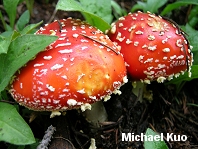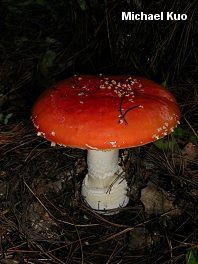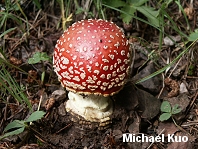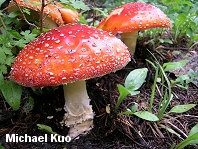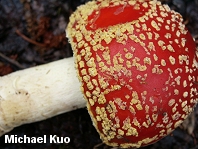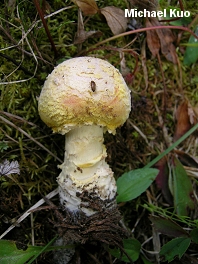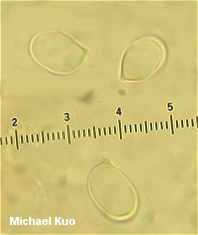| Major Groups > Gilled Mushrooms > Pale-Spored > Amanita > Amanita muscaria var. flavivolvata |

|
Amanita muscaria var. flavivolvata [ Basidiomycetes > Agaricales > Amanitaceae > Amanita . . . ] by Michael Kuo This is our continent's version of the classic Eurasian "toadstool," Amanita muscaria, which is probably the most depicted and recognized mushroom on earth--a fact in evidence even by my spelling checker's lack of objection to the species name; this almost never happens with fungi. To me, Amanita muscaria looks like those cut-out lawn decorations featuring an old farm woman in a polka-dotted dress bending over to tend flowers. Whatever it looks like to you, you'll probably agree that it is gorgeous. Our North American variety (or "subspecies," if you prefer) is distinguished by the fact that its universal veil and warts are yellow at first, though they quickly fade to white when exposed to sunlight--and by microscopic features. The defining features of the Amanita muscaria species group are:
The color of the cap in the muscaria group ranges from bright red (Amanita muscaria var. flavivolvata, described and illustrated here), to bright yellow (see Amanita muscaria var. guessowii), to white (Amanita muscaria var. alba). Compare Amanita muscaria with Amanita pantherina, which is brown and usually features a collar-like rim at the top of its bulb, rather than concentric zones--and with Amanita parcivolvata, which lacks a ring and has scattered flakes on its stem base, rather than concentric zones. The taxonomy of the Amanita muscaria species group will very likely change in the near future. A 2006 study by Geml and collaborators found DNA support for the idea that the color of the cap and warts in Amanita muscaria is not necessarily indicative of phylogenetic differences. The study used molecular dating techniques to hypothesize that "[t]he ancestral population of A. muscaria likely evolved in the Siberian-Beringian region and underwent fragmentation . . . The data suggest that these populations later evolved into species, expanded [sic] their range in North America and Eurasia" (225). As for the traditional morphological features separating "varieties," the researchers noted that among the species determined by DNA, "[a]ll . . . share at least two morphological varieties with other species, suggesting ancestral polymorphism in pileus and wart color pre-dating their speciations." Description: Ecology: Mycorrhizal with conifers and hardwoods (primarily oaks); summer and fall (and over winter in coastal California); fairly widely distributed in North America, but most common in the Pacific Northwest and Rocky Mountains (occasional--possibly introduced--in northeastern North America, apparently absent in the Midwest, rare in the southeastern United States, common in Mexico). Cap: 5-25 cm; nearly oval or round at first, becoming convex, then broadly convex to flat in age; bald; adorned with numerous small, cottony warts that are initially yellow but very quickly fade to white; deep to bright red, but sometimes fading with age to pale orange or pale yellow; the margin sometimes somewhat lined. Gills: Narrowly attached to the stem, or free from it; white; close or crowded; short-gills frequent. Stem: 5-18 cm long; 1-3 cm thick; more or less equal, or tapering to apex; with a swollen base; bald or shaggy; white; with a high, skirtlike ring; with concentric bands of universal veil material at the top of the bulb and/or on the lower stem. Flesh: White throughout; unchanging when sliced. Odor: Not distinctive. Spore Print: White. Microscopic Features: Spores 8-12 x 5-7 µ; smooth; broadly ellipsoid; inamyloid. Basidia 4-spored; clamped. Pileipellis an ixocutis of hyphae 2-9 µ wide. Lamellar trama bilateral; subhymenium ramose. REFERENCES: (Singer, 1958) Jenkins, 1977. (Smith, 1975; Smith, Smith & Weber, 1979; Thiers, 1982; Weber & Smith, 1985; Arora, 1986; Jenkins, 1986; States, 1990; Phillips, 1991/2005; Lincoff, 1992; Metzler & Metzler, 1992; Evenson, 1997; Barron, 1999; Geml et al., 2006; Miller & Miller, 2006; Binion et al., 2008; Trudell & Ammirati, 2009; Tulloss, 2013.) Herb. Kuo 08170308, 01131109. This site contains no information about the edibility or toxicity of mushrooms. |
© MushroomExpert.Com |
|
Cite this page as: Kuo, M. (2013, April). Amanita muscaria var flavivolvata. Retrieved from the MushroomExpert.Com Web site: http://www.mushroomexpert.com/amanita_muscaria_flavivolvata.html |
